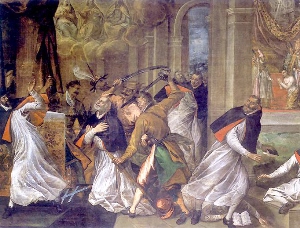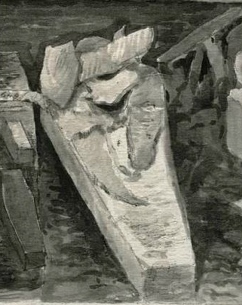How God Foiled the Bigamist and the Trollop
SOURCE-Note: Not an endorsement for sedevacantism
The Story of the Two Heretic Henries
And How the Catholic Church in Charity Administered Severe Punishment to Them
From: The TRADITIO Fathers

Thomas Beckett, Archbishop of Canterbury's Martyrdom
At the Hands of Heretic King Henry II of England
While Solemn Vespers Were Being Chanted at Canterbury Cathedral
As Depicted in Tommaso Dolabella's Martyrdom of Thomas Becket (1627)
To Keep His Crown, Henry II Was Forced to Do Public Penance --
Private Confession Was Not Sufficient for Such a Vile Sacrilege --
Crawling on His Hands and Knees from His Palace to Canterbury Cathedral
Where He Did Obeisance at the Martyr's Tomb
St. Thomas of Canterbury was proclaimed a martyr and canonized a Saint less than two years after King Henry II's (r. 1154-1189) knights assassinated him during Pontifical Vespers on December 29, 1170. Thomas and Henry had been in conflict over the authority of canon law and ecclesiastical courts. King Henry asked -- perhaps without realizing the consequences -- "Will no one rid me of this meddlesome priest?" Four knights viewed that question as a command and obeyed.
The four knights were excommunicated by Pope Alexander III, the same pope who canonized St. Thomas. To keep his crown, Henry II was forced to do public penance -- private confession was not sufficient for such a vile sacrilege -- crawling on his hands and knees from his palace to Canterbury Cathedral, where he did obeisance at the Martyr's tomb. That shrine, the monastery, and the relics of St. Thomas of Canterbury would last until 1538, when Henry II's successor, the heretic king Henry VIII, ordered the shrine destroyed, the monastery suppressed, and the Martyr's relics scattered.
But more about that to come in another Daily Commentary. For information about the 1964 award-winning film Becket, starring Richard Burton as the archbishop and Peter O'Toole as the king, click on FAQ12: What Films Do You Recommend for Traditional Catholics? in the TRADITIO Network's Library of Files: FAQs and Traditional Apologetics department.
True Catholics, that is how the true Church deals medicinally and punitively with those who dare to commit sacrilege. False "charity" -- which is not real charity at all, but pusillanimity -- is not an option. If such vile crimes are committed with impunity, the Church encourages others to commit similar crimes. And that, in a nutshell, describes the Newchurch of the New Order since the Vatican II Anti-council (1962-1965), whose Newpopes and Newprelates are complicit in the vilest of crimes: sacrilege, blasphemy, idolatry, heresy, schism, infidelty, and paganism.
The Rest of the Story of the Two Heretic Henries
How God Foiled the Bigamist and the Trollop

The Unearthed Coffin of the Heretic King Henry VIII
Excommunicated by Pope Paul III on December 17, 1538
Just as a Franciscan Had Preached to Him:
"God's Judgments Are Ready to Fall upon Your Head
And Dogs Will Lick Your Blood, as They Had Done To Ahab"
During the Night after Henry's Death
"Corrupted Matter of a Bloody Color" Fell from the Coffin to the Floor
And Dogs Did in Fact Lick the Corruption of the Heretic King
Henry wanted to make sure that everyone of importance accepted his actions, so his agents presented a series of oaths to Henry's subjects. All the English bishops swore the oaths of Succession and of Supremacy -- except one, St. John Fisher, who was martyred for his fidelity to the Catholic Church. Nor did the king's chancellor, St. Thomas More, take the oath and was also martyred for his fidelity to the Catholic Church.
The heretic Henry VIII even reached back 400 years in his vendetta against the Catholic Church. As Archbishop of Canterbury, Thomas Becket (1119-1170) fiercely espoused the independence of the Catholic Church from royal authority, and his sacrilegious assassination in 1170 at the hands of Henry II's knights made him a Martyr and a popular hero.? For Henry VIII the lesson was clear --?a religious leader who had defied the king and been canonized for it was a dangerous precedent during a time of great religious rebellion.
Therefore, in April 1538, Henry VIII set about eradicating the legacy of St. Thomas of Canterbury in England. Henry ordered destroyed the Martyr's shrine at Canterbury Cathedral and images of the Martyr throughout England. Henry also ordered that the Martyr's feastday on December 29 be removed from the liturgical calendar. (Not surprisingly, Newpope Paul VI-Montini, the Newpope of the Vatican II Anti-council [1962-1965], similarly ordered the Martyr's feastday demoted to a mere "memorial" in the New Order sect.)
This attack on a Saint proclaimed by the Church was the final blow for Pope Paul III (r. 1534-1549), who issued a decree of excommunication against Henry on December 17, 1538. This courageous pope didn't believe in false "charity." With Henry's actions against St. Thomas of Canterbury, and against other Saints' shrines, including the Marian shrines throughout England, it was clear that Henry VIII was a full-blown heretic.
True Catholics, "Be not deceived: God is not mocked" (Galatians 6:7/DRV). Henry VIII is remembered as the vile adulterer of six wives, while Canterbury Cathedral became one of the great shrines of Christendom, with pilgrims coming from throughout England and the Continent "the holy, blissful martyr for to see," as the Canterbury Tales put it.